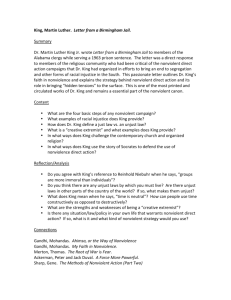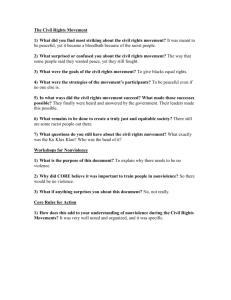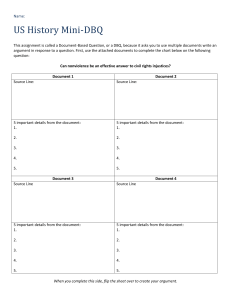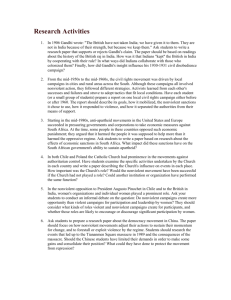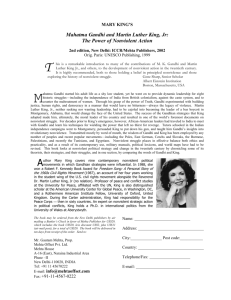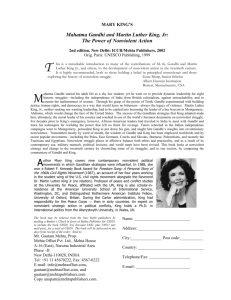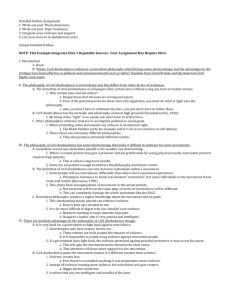Nonviolence in the 1960s and 1970s: theories and critiques
advertisement
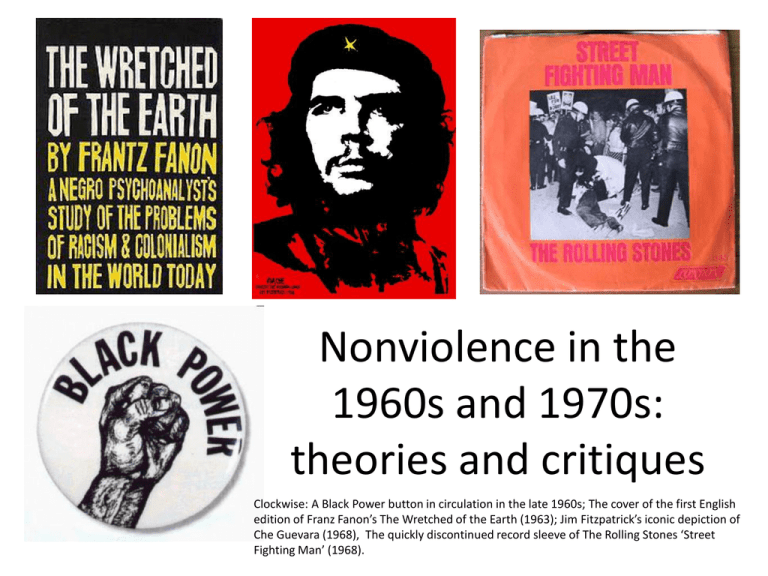
Nonviolence in the 1960s and 1970s: theories and critiques Clockwise: A Black Power button in circulation in the late 1960s; The cover of the first English edition of Franz Fanon’s The Wretched of the Earth (1963); Jim Fitzpatrick’s iconic depiction of Che Guevara (1968), The quickly discontinued record sleeve of The Rolling Stones ‘Street Fighting Man’ (1968). Key Questions •Can the liberating effect of revolutionary violence be achieved through nonviolent means? •Is nonviolence futile against extremely violent and unscrupulous regimes? •Does violence help or hinder revolutionary change? Black Power in the USA: ‘Fires of Frustration’ Frustrated that the judicial and legislative victories of the civil rights era had failed to make any impact on life in the Ghettos, many blacks turned towards violence. 1964-Ghettos in Rochester, Harlem, and Philadelphia erupted.- followed by Washington, Baltimore, San Francisco, Detroit, Cleveland , and Chicago. 1965 Watts L.A riot (34 killed/4000 wounded) •key Debate: Lance Hill, The Deacons for Defense: Armed Resistance and the Civil Rights Movement (North Carolina, 2004). James A. Colaiaco, ‘Martin Luther King, Jr. and the Paradox of nonviolent Direct Action’, Phylon ,vol 47 (1986), pp. 16-28 •A Critique of Mahatma Gandhi’s nonviolent philosophy: "The concept of nonviolence is a false ideal. It presupposes the existence of compassion and a sense of justice on the part of one's adversary. When this adversary has everything to lose and nothing to gain by exercising justice and compassion, his reaction can only be negative.“(George Jackson/Black Panther) " I believe it's a crime for anyone being brutalized to continue to accept that brutality without doing something to defend himself.“ (Malcom X/ Nation of Islam) •Black Pride: Nonviolence in a new guise? The Black Panthers: From Revolutionary rhetoric and armed confrontation to free health clinics and liberation schools. Franz Fanon: the Catharsis of Violence ‘If the black man’s pent-up resentments and latent frustrations are not released through nonviolent marches, sit-ins, and Freedom Rides, they will come out in ominous expressions of violence. This is not a threat; it is a fact of history.’ (Martin Luther King Jr.) •Theory: (As outlined in Fanon’s The Wretched of the Earth) In the colonial context, revolutionary violence is crucial to the process of empowering the disempowered . Through orchestrating acts of violence against the European oppressor, the colonized peoples are able to purge themselves of their degradation. •Critique: (As outlined in Barbara Deming’s ‘On Revolution and Equilibrium’) 1925 He was born in Martinique, studied medicine and psychiatry at the University of Lyon and served in the French Army during the Second World War. 1952 He published Black Skin, White Masks. 1953–56 He served as head of the psychiatry department of Blida-Joinville Hospital in Algeria. 1954 He joined the Algerian Liberation Movement. 1961 He published The Wretched of the Earth and soon after died of Leukemia. Fanon wrote that the resort to violence could lead to an ‘attack of vertigo’, creating doubt and anguish about the consequences of one’s actions. However, ‘If we wage battle without violence we can remain very much in control of our own selves, of the responses to us which our adversaries make, of the battle as it proceeds, and of the future we hope will issue from it.’ •Barbara Deming was not only one of the first to define nonviolence on purely pragmatic terms, she attempted to reconcile nonviolence with revolution. ‘We refuse the authorities our labor, we refuse them our money,…we refuse them our bodies (to fight in wars). Those who employ nonviolent methods have simply never gone as far as they could in this direction.’ China, Cuba and Vietnam: successful insurgencies • "I believe that there is no country in the world including any and all the countries under colonial domination, where economic colonization, humiliation and exploitation were worse than in Cuba, in part owing to my country’s policies during the Batista regime. I approved the proclamation which Fidel Castro made in the Sierra Maestra, when he justifiably called for justice and especially yearned to rid Cuba of corruption. I will even go further: to some extent it is as though Batista was the incarnation of a number of sins on the part of the United States. Now we shall have to pay for those sins. In the matter of the Batista regime, I am in agreement with the first Cuban revolutionaries. That is perfectly clear.“ John F Kennedy (October 1963) • Guerrilla warfare in Indochina: an indication of nonviolent potential? • Barbara Demming attempted to combine Gandhi’s and Castro’s ideas into a revolutionary nonviolent philosophy. The Cult of Che Guevara •Che Guevara's focal theory of Revolution and the immortalization of the heroic resistance fighter. The mystique of Che has created not only a cult but a new source of profits for composers, poster makers and book publishers. "Everybody is jumping on the Guevara bandwagon," says Vice Chairman Rayner Unwin of the London publishing house of Allen & Unwin. Four Italian publishers are working the field, including Milan's Giangiacomo Feltrinelli, whose 95¢ version of Che's handbook. Guerrilla Warfare, has gone into three editions totaling 40,000 copies. At least half a dozen moviemakers are scrambling to get on-screen first with a Guevara biography. Most of them are Europeans, but in the U.S., Director Richard Fleischer, who has just completed The Boston Strangler, is ready to begin work for 20th Century-Fox on a film entitled simply Che. (Time, 17 May 1968) 1968: the Students Revolt Students from California to Paris rebelled against the pitiful state of their education system. They challenged their institutions bourgeoisie bias, autocratic structure and financial corruption. Classic Marxist perspective: ‘Passive resistance was a contradiction, resistance that was no resistance, a product of the bourgeoisie’s recognition of the need for resistance coupled with its fear to act accordingly.’ (Micheal Randle) ‘The “legal basis” meant that the legal title of the people, revolution, did not exist in the contract social between the government and the bourgeoisie.’ (Karl Marx) New Left perspective: Drawing upon incidences of contemporary social unrest, most notably the student riots in Turkey, South Korea and the left-wing revolution in Cuba, C. Wright Mills concludes that it is the young intelligentsia not labour that are the present agency of change. •Hannah Arendt argues that the valorization of violence by the New Left in the 1960s and 1970s was a departure from classic Marxism. Eco-sabotage: The monkey Wrench Gang •Gandhi ruled out sabotage and objected to property damage. •In Deming’s opinion acts of sabotage should only be directed against ‘property that is by its nature deathly or exploitative, and unambiguously so.’ •Gene Sharp included sabotage in his list of legitimate nonviolent action methods. •The most spectacular incidents occurred in July 1972 when two of the navy’s aircraft carriers, the U.S.S Forrestal and the U.S.S Ranger, were put out of action by sailors aboard ship. •Ecoterrorism: fire-bombing and tree-spiking. Born from frustration? •Greenpeace: tree-sitting, blockading and trespassing. More effective? From Principles to Pragmatics: reinvigorating the nonviolent debate •Inspiration derived from the American tradition of nonviolence. (individualistic and voluntaristic assumptions) • A government’s power over its subjects is based on their obedience and cooperation. •Sharp rejects the monolithic theory of power in favour of a relational view that locates the sources of power within society. (Authority, human resources, skills and knowledge, sanctions, intangible and material resources.) •Methods of Nonviolent Action: protest and persuasion, nonviolent intervention, noncooperation •Mechanisms of Change: conversion, accommodation, nonviolent coercion, Disintegration. ‘In contrast to the principled approach to nonviolence, in which nonviolent methods are used as a matter of principle and the activists implementing them must adhere to a moral code, the pragmatic approach merely assumes that in some contexts nonviolent action may be more effective than violent action in promoting social and political change. The morality or beliefs of nonviolent proponents or activists are not at issues.’ (Kurt Schock) Conclusion • • • • • By the end of the 1970s the image of Gandhi as a dreamer unworthy of serious contemplation had been replaced with that of a shrewd tactician and strategist. Through shedding nonviolence of its moral, spiritual and philosophical dimensions, Gene Sharp was able to create a highly exportable manual for political and social change. Nonviolence has not succeeded against the world’s most ruthless dictators but in time, a more nuanced version may triumph. As Gandhi admitted, nonviolence is still very much in its infancy. Indeed, Revolutionary nonviolence is yet to fulfill its potential. The role of violence in the success of nonviolent campaigns has been hotly debated, in some instances it has certainly worked to the advantage of the campaign, but that does not necessarily mean that it was intrinsic to its success. As nonviolent strategy and tactics are honed, nonviolent resistance will be able to deliver the revolutionary impulse that the oppressed craved and were left wanting in the 1960s and 1970s.
